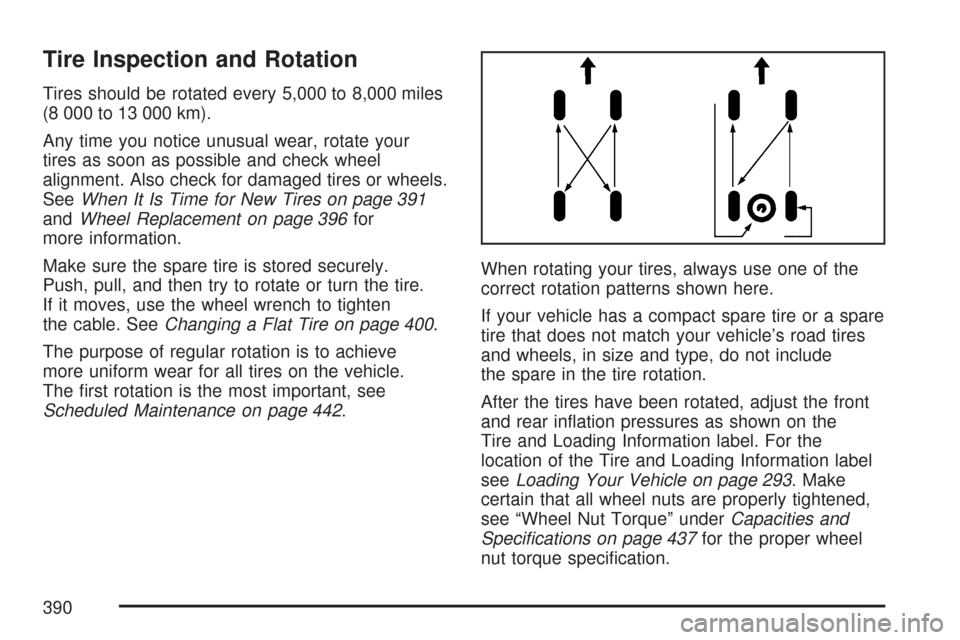Page 390 of 496

Tire Inspection and Rotation
Tires should be rotated every 5,000 to 8,000 miles
(8 000 to 13 000 km).
Any time you notice unusual wear, rotate your
tires as soon as possible and check wheel
alignment. Also check for damaged tires or wheels.
SeeWhen It Is Time for New Tires on page 391
andWheel Replacement on page 396for
more information.
Make sure the spare tire is stored securely.
Push, pull, and then try to rotate or turn the tire.
If it moves, use the wheel wrench to tighten
the cable. SeeChanging a Flat Tire on page 400.
The purpose of regular rotation is to achieve
more uniform wear for all tires on the vehicle.
The �rst rotation is the most important, see
Scheduled Maintenance on page 442.When rotating your tires, always use one of the
correct rotation patterns shown here.
If your vehicle has a compact spare tire or a spare
tire that does not match your vehicle’s road tires
and wheels, in size and type, do not include
the spare in the tire rotation.
After the tires have been rotated, adjust the front
and rear in�ation pressures as shown on the
Tire and Loading Information label. For the
location of the Tire and Loading Information label
seeLoading Your Vehicle on page 293. Make
certain that all wheel nuts are properly tightened,
see “Wheel Nut Torque” underCapacities and
Speci�cations on page 437for the proper wheel
nut torque speci�cation.
390
Page 393 of 496

CAUTION: (Continued)
Your vehicle may have a compact spare
tire and wheel assembly. If the vehicle
has a compact spare tire and wheel,
they have the same overall diameter
as your vehicle’s full-size tires and
wheels. Because they were designed
and developed for use on your vehicle,
it is all right to drive your vehicle with
the compact spare installed properly.
Compact spare tires are designed for
temporary use only. SeeSpare Tire
on page 420.
{CAUTION:
If you use bias-ply tires on your vehicle,
the wheel rim �anges could develop
cracks after many miles of driving. A tire
and/or wheel could fail suddenly, causing
a crash. Use only radial-ply tires with
the wheels on your vehicle.
If you must replace your vehicle’s tires with
those that do not have a TPC Spec number,
make sure they are the same size, load range,
speed rating, and construction type (radial and
bias-belted tires) as your vehicle’s original tires.
Your vehicle’s original equipment tires are listed
on the Tire and Loading Information Label.
This label is attached to the vehicle’s center pillar
(B-pillar). SeeLoading Your Vehicle on page 293,
for more information about the Tire and Loading
Information Label and its location on your vehicle.
393
Page 418 of 496
7. Make sure the tire is stored securely. Push,
pull (A), and then try to turn (B) the tire.
If the tire moves, check to make sure the
tire valve stem is pointing down, then use
the wheel wrench to loosen and then
tighten the cable.To store the tools, do the following:
1. Return the wheel wrench, jack extensions
and the storage bag to the locations
described underRemoving the Spare
Tire and Tools on page 401.
2. Install the wheel blocks �rst.
Then install the jack.
3. Secure the items in the vehicle as
shown next.
418